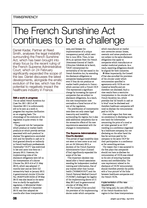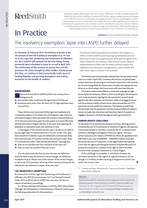Description
L E G A L LY S P E A K I N G
by Thomas W. Greeson and Paul Pitts
service. Any services the radiologist extender performs in a
physician office setting or freestanding imaging center that
are not diagnostic testing services must be performed under a
physician’s direct supervision.5
In order for the radiologist extender’s services to be covered
“incident to” the services of a physician, the procedure must
be: 1) an integral, although incidental, part of the physician’s
professional services; 2) commonly rendered without
charge or included in the physician’s bill; 3) of a type that
is commonly furnished in physicians’ offices or clinics; and
4) furnished under the physician’s direct supervision. Direct
supervision in the office setting means the physician must
be present in the office suite and immediately available and
able to provide assistance and direction throughout the time
the service is performed.
Direct supervision does not mean that the physician must be present in the same room with his or her aide.6 Only those procedures that are within the RA’s or RPA’s scope of practice (and for which the individual is qualified to perform) may be furnished as an incident to service by that radiologist extender. As noted above, RAs and RPAs may not perform interventional radiology services that bill as physician services in a hospital setting. The Medicare coverage and payment rules are complex—and quite arcane—but it is essential that IRs try to understand them and to be compliant in working with physician extenders. References 1. See Medicare Benefit Policy Manual, Pub. 100-02, Ch 15, §60.1. 2. See Social Security Act § 1861(s)(2)(A). 3. See e.g.
“Medicare Access to Radiology Care Act” 4. See 42 C.F.R. § 410.28(e). 5. See Medicare Benefit Policy Manual (PUB. 100-02), Ch.
15, § 60.2. 6. See id. at § 60.1. Tom Greeson and Paul Pitts are partners in the law firm of Reed Smith LLP. Tom is in the Northern Virginia office, and Paul is located in the firm’s San Francisco office. WINTER 2016 | I R Q U A R T E R LY 19 .
Direct supervision does not mean that the physician must be present in the same room with his or her aide.6 Only those procedures that are within the RA’s or RPA’s scope of practice (and for which the individual is qualified to perform) may be furnished as an incident to service by that radiologist extender. As noted above, RAs and RPAs may not perform interventional radiology services that bill as physician services in a hospital setting. The Medicare coverage and payment rules are complex—and quite arcane—but it is essential that IRs try to understand them and to be compliant in working with physician extenders. References 1. See Medicare Benefit Policy Manual, Pub. 100-02, Ch 15, §60.1. 2. See Social Security Act § 1861(s)(2)(A). 3. See e.g.
“Medicare Access to Radiology Care Act” 4. See 42 C.F.R. § 410.28(e). 5. See Medicare Benefit Policy Manual (PUB. 100-02), Ch.
15, § 60.2. 6. See id. at § 60.1. Tom Greeson and Paul Pitts are partners in the law firm of Reed Smith LLP. Tom is in the Northern Virginia office, and Paul is located in the firm’s San Francisco office. WINTER 2016 | I R Q U A R T E R LY 19 .













